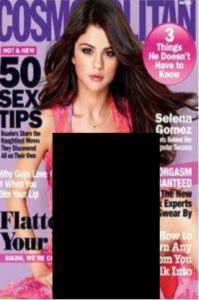Warning: Article discusses sexually explicit themes. Reader discretion advised.
By Leanne Miller, NCOSE Intern.
Just about everyone who knows the name Playboy knows that it has pornographic objectives and an explicit sexual rhetoric. Even though its mission is to be “an arbiter of style and a vanguard for political, sexual and economic freedom,” its reputation is clear. No one is fooled into thinking that Playboy is anything more than a porn magazine.
While Cosmopolitan magazine is not hardcore pornography, it is nonetheless sexually explicit, degrading, and fuels pornified culture, in ways similar to Playboy.
Research has shown that Cosmopolitan and Playboy magazines showed similar concepts about sexuality and women’s sexual attractiveness to the audience. But unlike Playboy, Cosmo’s sexual rhetoric is not always clear to consumers, especially young teenage girls. I mean, how could you expect a young girl to know the magazine is for adults when the cover is bubble-gum pink and has her favorite Disney star on it?
Cosmopolitan magazine hounds American shoppers from grocery store checkout lanes with covers that pronounce the latest in recycled sex tricks and that flaunt hypersexualized and objectified cover models over and over again. As for its content, Cosmopolitan relentlessly normalizes risky sexual practices such as public, anal, group, and sadomasochistic sex to its young female readership. For instance, in the February 2016 issue the article “The Swing” tells readers “Monogamy is seen as the gold standard, but other relationship models—throuples, quads!—are emerging from the sidelines and shedding their stigma.”
This sexually explicit material is reaching young teen girls despite the Cosmo myth that it’s meant for 18-49 year-olds.
This is not an accident. Cosmopolitan is purposely trying to bring in younger readers.

So why is Joe Jonas, star of Disney Channel’s popular Camp Rock movies and lead singer of the band The Jonas Brothers, discussing his sex bucket list, including having sex in elevators, with readers in the January 2017 issue? Or why is Zayn, a singer from every young girl’s favorite boy band, One Direction, featured as “Mr. July” 2016? Young stars being paired with adult content has us asking, “Who’s the target audience again?” And Joe Jonas and Zayn aren’t the only Disney or teen personalities Cosmo’s recruited to attract young readers. Zendaya, star of Disney Channel’s sitcom “Shake it Up”, was the July 2016 cover model and other issues have featured Disney stars like Demi Lovato, Miley Cyrus, and Selena Gomez. Cosmo didn’t feature these stars believing they would attract their 30+ year-old readers.
Cosmo isn’t attracting underage readers by magazine covers and articles alone. Their greatest reach is mostly achieved by their website and social media platforms. Cosmo is available to its readers via Twitter, Snapchat, and Instagram–the best places for reaching teenagers today. The articles presented on its website and social media sites are even more sexually explicit than the magazine. Here are just a few examples:
“I Have a Sugar Daddy So I Can Support My Son. Here’s What My Life Is Like”
Introduces readers to website where “sugar daddies” connect with “sugar babies.”
“Here’s What 7 People Actually Bring to Sex Parties”
Normalizes sex parties, group sex, and multiple-partner relationships.
“You Have Got to Check Out the Fifty Shades Darker Sex Toys”
Promotes the Fifty Shades of Grey sequel and line of sex toys including vibrators, nipple clamps, anal plugs, and even a ‘replica’ of the bow tie Christian uses to tie up Ana.
“Sex Workers Open Up About Their Most Expensive Service”
Normalizes “The Girlfriend Experience” and prostitution as “sex work.”
“12 BDSM-Style Sex Toys You’ve Got To Try”
Promotes bondage-style sex and toys.
“What It’s Really Like to Have a Threesome”
Article normalizing group sex.
“Is Porn the Answer to Zika in Rio?”
Promotes a pornography website.
Cosmo’s Snapchat Stories, in particular, have been proven sexually explicit. Their Snapchat Stories have included articles like “24 Times Celeb Nipples Wanted All the Attention,” and “10 Things He Thinks about Your Vagina.” Not only are these explicit articles available to underage Snapchat users, they’re mixed in with other articles that attract teenage girls. For example, the Snapchat article “15 Seriously Cute Promposals Any Girl Can Pull Off” is about girls mustering up the courage to ask boys to prom. What 20 to 34-year-old attends the prom?
Why does this all matter? Well, according to research, when these teen girls read the sexually provocative, explicit, degrading, and pornified content they learn to self-objectify.
Evidence suggests that “sexualization contributes to impaired cognitive performance in college-aged women,” and that viewing sexually objectifying material “can contribute to body dissatisfaction, eating disorders, low self-esteem, depressive affect, and even physical health problems” in teenaged girls and in young women.
Just as we all know that Playboy is known for its pornography and explicit sexual objectives, so too Cosmo should be looked upon with equal distaste.
Don’t let Cosmo fool you into thinking it’s a magazine about empowering women.
There is nothing empowering about this sexually explicit, degrading, and pornified publication. Instead, Cosmo should be labeled as it truly is: an anti-woman magazine that promotes the sexual exploitation and degradation of women.
If you’re standing in a retail checkout lane, you don’t find Playboy magazine for sale. Why is the same not true for Cosmopolitan magazine? Cosmopolitan should be removed from retail checkout lanes and labeled as sexually explicit/adult material.
Let’s not let teenage cover models or luring social media like “Lisa Frank Wants to Make the Rainbow Makeup Collection of Your Dreams” or bubble gum pink graphics confuse our daughters any longer.



